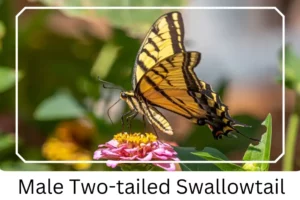Two-tailed Swallowtail (Papilio multicaudata)
The Two-tailed Swallowtail (Papilio multicaudata) is a magnificent species of butterfly that graces the western and central parts of North America, extending its beauty down through Central America. Celebrated for its distinctive appearance and broad distribution across diverse habitats, this butterfly is a subject of admiration among enthusiasts and researchers alike. In this detailed guide, we explore the rich tapestry of life stages and characteristics that define the Two-tailed Swallowtail.
Scientific Classification
- Family: Papilionidae
- Genus: Papilio
- Common names: Two-tailed Tiger Swallowtail
- Scientific Name: Papilio multicaudata
Overview
Belonging to the family Papilionidae, the Two-tailed Swallowtail showcases a vibrant yellow to orange-yellow hue on its wings, complemented by thick black borders and unique patterns that distinguish it from its counterparts. Its presence is a common sight during the summer months across a range of urban and wild areas, making it a familiar spectacle in gardens, parks, and natural reserves. Through the lens of conservation and admiration, understanding the Two-tailed Swallowtail’s life cycle, habitat preferences, and ecological role is essential for preserving its population and appreciating its role in the environment.
Description and Identification
Caterpillar

The journey of the Two-tailed Swallowtail begins with its caterpillar stage, where it exhibits a mottled black and white coloration, mimicking bird droppings to evade predators. As it matures, the caterpillar transforms, displaying either an orange-brown or bright green hue, adorned with eye-catching eyespot markings near the thorax, a masterful adaptation for survival.
Pupa
Transitioning to the pupa stage, the chrysalis adopts a gray-brown color, blending seamlessly with its surroundings. This camouflage is crucial for its development into the next stage, hidden away from the prying eyes of predators.
Adult Butterfly
Upon reaching adulthood, the Two-tailed Swallowtail reveals its full splendor.
Sexual Dimorphism: There are no visible differences between males and females, making identification based on gender a challenge for observers.
Color and Appearance: With wings unfurled, the adult butterfly displays a dazzling yellow to orange-yellow base color, edged with pronounced black borders. The wings feature parallel stripes and a unique pattern of purplish-blue patches and orange spots on the secondary wings, creating a mesmerizing effect.

 Average Wingspan: The Two-tailed Swallowtail boasts an impressive wingspan ranging from 3.5 to 5.5 inches, contributing to its majestic appearance during flight.
Average Wingspan: The Two-tailed Swallowtail boasts an impressive wingspan ranging from 3.5 to 5.5 inches, contributing to its majestic appearance during flight.
Flight Pattern: Observers will note the butterfly’s slow and erratic flight pattern, a characteristic dance through the air that captivates onlookers.
Eggs
The reproductive cycle begins anew with the laying of rounded, yellowish eggs, deposited singly on the leaves of host plants, ensuring the next generation’s survival.
Quick Facts | |
| Distribution | This species spans the western parts of North America, reaching from British Columbia through central Nebraska and Texas, and extending south through Mexico. |
| Habitat | It thrives in foothills, valleys, canyons, woodlands, and even urban environments such as parks, roadsides, and gardens. |
| Lifespan of Adults | The adult butterfly enjoys a brief but vibrant life, lasting from 6 to 14 days. |
| Host Plants | Key to its survival, the caterpillar feeds on a variety of plants, including cherry, ash, willow, hoptree, poplar, and chokeberry. |
| Adult Diet | The adult butterflies sustain themselves on the nectar of flowers, playing a role in pollination. |
How to Identify Two-tailed Swallowtail?
Identifying the Two-tailed Swallowtail butterfly can be an enriching experience, thanks to its distinctive features and vibrant colors. Look for the large, yellow to orange-yellow wings adorned with thick black borders and parallel stripes. The presence of purplish-blue patches and orange spots at the end of the secondary wings is a hallmark of this species. When observing the butterfly in motion, note its slow, erratic flight pattern, which distinguishes it from other swift-flying butterflies. By familiarizing yourself with these characteristics, enthusiasts can appreciate the beauty and ecological significance of the Two-tailed Swallowtail in their natural surroundings.
Did You Know?
- In 2001, Arizona proudly designated the Two-tailed Swallowtail as its official state butterfly, a testament to the species’ emblematic status in the region.
- The Two-tailed Swallowtail’s ability to camouflage at different stages of its life cycle, from resembling bird droppings as a caterpillar to blending into the environment as a pupa, is a remarkable example of evolutionary adaptation.
Conclusion
The Two-tailed Swallowtail butterfly is not just a spectacle of beauty with its vivid colors and graceful flight but also a fascinating subject for study due to its unique life stages and adaptive strategies. Through understanding and appreciating this butterfly, we can better appreciate the intricate balance of nature and the importance of conservation efforts to preserve such magnificent creatures for future generations to enjoy.
Two-tailed Swallowtail Pictures

Scientific Classification

- Family: Papilionidae
- Genus: Papilio
- Common names: Two-tailed Tiger Swallowtail
- Scientific Name: Papilio multicaudata







